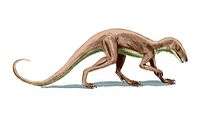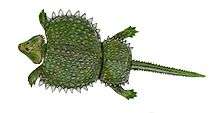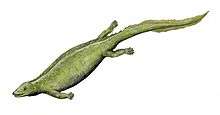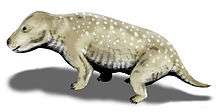Ladinian
| System/ Period |
Series/ Epoch |
Stage/ Age |
Age (Ma) | |
|---|---|---|---|---|
| Jurassic | Lower/ Early |
Hettangian | younger | |
| Triassic | Upper/ Late |
Rhaetian | 201.3 | ~208.5 |
| Norian | ~208.5 | ~227 | ||
| Carnian | ~227 | ~237 | ||
| Middle | Ladinian | ~237 | ~242 | |
| Anisian | ~242 | 247.2 | ||
| Lower/ Early |
Olenekian | 247.2 | 251.2 | |
| Induan | 251.2 | 251.902 | ||
| Permian | Lopingian | Changhsingian | older | |
| Subdivision of the Triassic system according to the ICS, as of 2018.[1] | ||||
The Ladinian is a stage and age in the Middle Triassic series or epoch. It spans the time between 242 Ma and ~237 Ma (million years ago).[2] The Ladinian was preceded by the Anisian and succeeded by the Carnian (part of the Upper or Late Triassic).[3]
The Ladinian is coeval with the Falangian Chinese regional stage.
Stratigraphic definitions
The Ladinian was established by Austrian geologist Alexander Bittner in 1892. Its name comes from the Ladin people that live in the Italian Alps (in the Dolomites, then part of Austria-Hungary).
The base of the Ladinian stage is defined as the place in the stratigraphic record where the ammonite species Eoprotrachyceras curionii first appears or the first appearance of the conodont Budurovignathus praehungaricus. The global reference profile for the base (the GSSP) is at an outcrop in the river bed of the Caffaro river at Bagolino, in the province of Brescia, northern Italy.[4] The top of the Ladinian (the base of the Carnian) is at the first appearance of ammonite species Daxatina canadensis.
The Ladinian is sometimes subdivided into two subages or substages, the Fassanian (early or lower) and the Longobardian (late or upper). The Ladinian contains four ammonite biozones, which are evenly distributed among the two substages:
- zone of Frechites regoledanus
- zone of Protrachyceras archelaus
- zone of Protrachyceras gredleri
- zone of Eoprotrachyceras curionii
Palaeontology
Many Ladinian and Carnian vertebrates have been discovered in the paleorrota in Brazil: Rhynchosaurs, thecodonts, exaeretodonts, Staurikosaurus, Guaibasaurus, Saturnalia tupiniquim, Sacisaurus, Unaysaurus, and many others. Paleorrota lies within the Santa Maria Formation and the Caturrita Formation.
Vertebrates of Ladinian age include:
Amphibians
| Amphibians of the Ladinian | ||||
|---|---|---|---|---|
| Taxa | Presence | Location | Description | Images |
Archosaurs
| Archosaurs of the Ladinian | ||||
|---|---|---|---|---|
| Taxa | Presence | Location | Description | Images |
| All across Europe | Zanclodon is the name formally used for fossil material that might actually belongs to at least two genera of dinosaur from the Late Triassic among other genera. | |||
Dinosauromorphs
| Dinosauromorphs of the Ladinian | ||||
|---|---|---|---|---|
| Taxa | Presence | Location | Description | Images |
| Argentina |
| |||
Suchians
| Suchians of the Ladinian | ||||
|---|---|---|---|---|
| Taxa | Presence | Location | Description | Images |
| Erfurt Formation, Germany | ||||
| Switzerland, Italy | ||||
†Placodonts
| Placodonts of the Ladinian | ||||
|---|---|---|---|---|
| Taxa | Presence | Location | Description | Images |
|
| ||||
Therapsids
| Therapsids of the Ladinian | ||||
|---|---|---|---|---|
| Taxa | Presence | Location | Description | Images |
|
| ||||
|
Santa Maria Formation, Brazil and Omingonde Formation, Namibia |
||||
See also
- Paleorrota
References
Notes
- ↑ "International Chronostratigraphic Chart" (PDF). International Commission on Stratigraphy. 2018.
- ↑ http://www.stratigraphy.org/index.php/ics-chart-timescale
- ↑ For a detailed geologic timescale see Gradstein et al. (2004)
- ↑ The GSSP was established by Brack et al. (2005)
Literature
- Bittner, A.; 1892: Was ist norisch?, Jahrbuch der kaiserlich-königlichen geologischen Reichsanstalt 42(3), pp. 387–396. (in German)
- Brack, P.; Rieber, H.; Nicora, A. & Mundil, R.; 2005: The Global boundary Stratotype Section and Point (GSSP) of the Ladinian Stage (Middle Triassic) at Bagolino (Southern Alps, Northern Italy) and its implications for the Triassic time scale, Episodes 28(4), pp. 233–244.
- Gradstein, F.M.; Ogg, J.G. & Smith, A.G.; 2004: A Geologic Time Scale 2004, Cambridge University Press.
External links
- GeoWhen Database - Ladinian
- Upper Triassic and Lower Triassic timescales, at the website of the subcommission for stratigraphic information of the ICS
- Norges Network of offshore records of geology and stratigraphy: Stratigraphic charts for the Triassic, and



